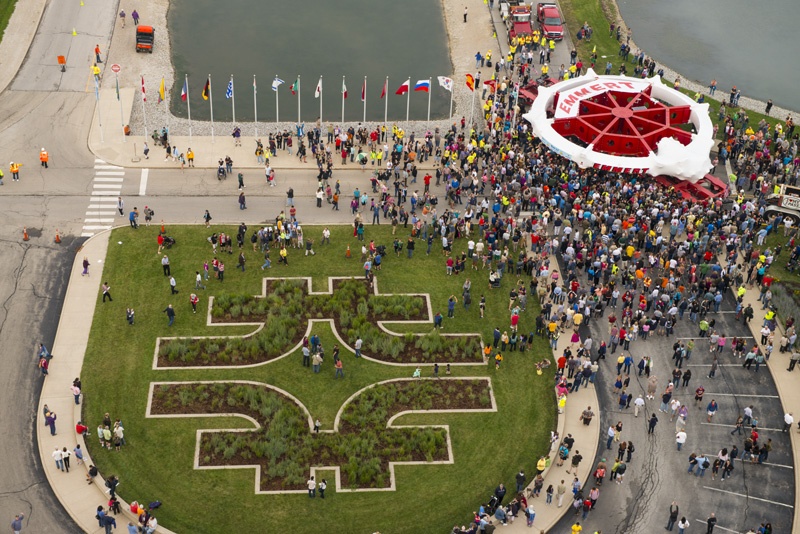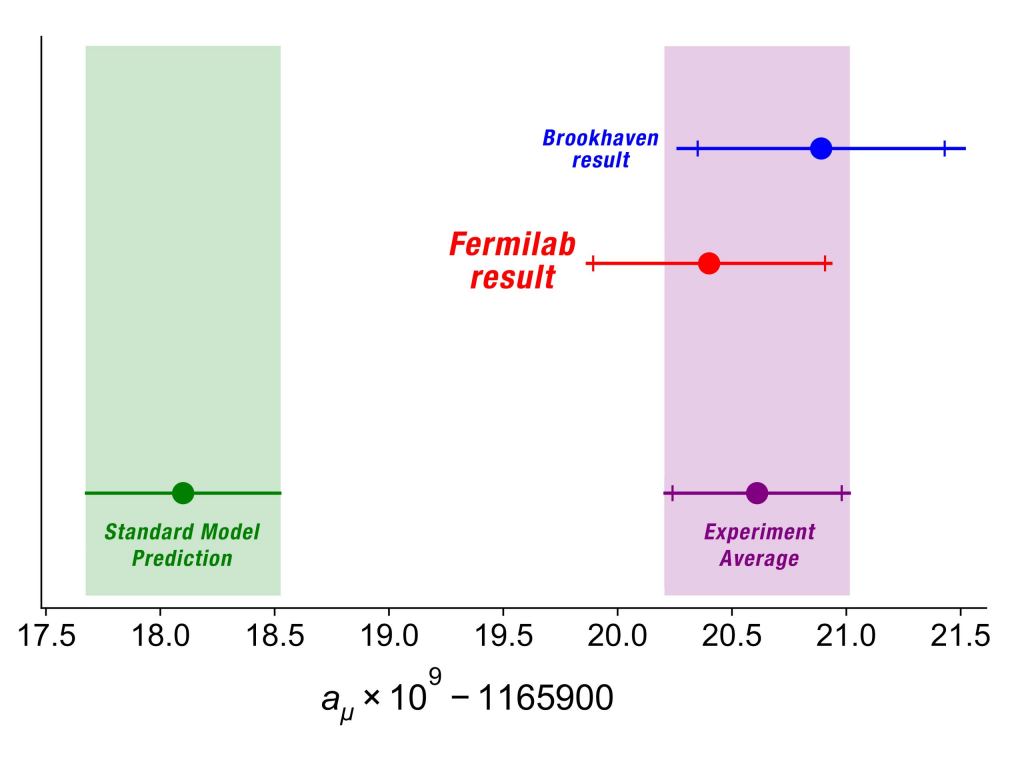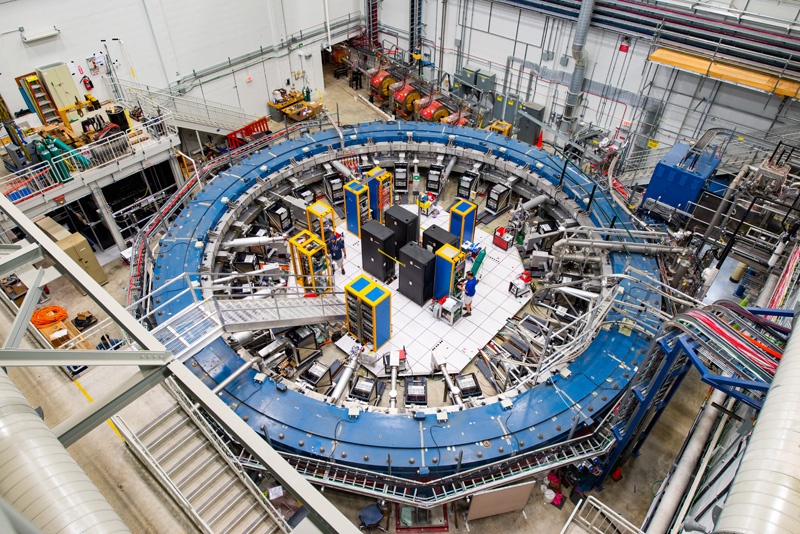Fermilab’s Muon g-2 Experiment Finally Gives Particle Physicists a Hint of What Lies Beyond the Standard Model
By Matt Williams
Since the long-awaited detection of the Higgs Boson in 2012, particle physicists have been probing deeper into the subatomic realm in the hope of investigating beyond the Standard Model of Particle Physics. In so doing, they hope to confirm the existence of previously unknown particles and the existence of exotic physics, as well as learning more about how the Universe began.
At the Fermi National Accelerator Laboratory (aka. Fermilab), researchers have been conducting the Muon g-2 experiment, which recently announced the results of their first run. Thanks to the unprecedented precision of their instruments, the Fermilab team found that muons in their experiment did not behave in a way that is consistent with the Standard Model, resolving a discrepancy that has existed for decades.
Experiments involving muons began decades ago at the European Organization for Nuclear Research (CERN) and were conducted recently at the Brookhaven National Laboratory (BNL) in New York. In 2011, Fermilab took over where the BNL left off and began dedicating its powerful accelerators to exploring the interactions of short-lived muon particles with a strong magnetic field in a vacuum.
Similar to electrons (but with 200 times more mass), muons occur naturally when cosmic rays strike Earth’s atmosphere. Another similarity is the way muons behave like spinning magnets, the strength of which determines the rate at which they precess (gyrate) in an external magnetic field (and is known as the “g-factor“). In the case of muons, their g-factor is slightly greater than 2 (hence the name of the experiment).
The purpose of the Muon g-2 experiment is to examine the precession rate of muons while subjected to a strong magnetic field. By measuring their g-factor to a precision of 0.14 parts per million (ppm), the researchers who make up the Muon g?2 Collaboration hope to see if their behavior is consistent with predictions made by the Standard Model (SM). If not, that would indicate that there are physics that go beyond the SM that need to be accounted for.
Graziano Venanzoni, a physicist at the Italian National Institute for Nuclear Physics (INFN), is also the co-spokesperson of the Muon g-2 experiment. As he announced on April 7th, during the seminar where the results of the first run were made public, the results were inconsistent with what the SM predicts:
“Today is an extraordinary day, long-awaited not only by us but by the whole international physics community. A large amount of credit goes to our young researchers who, with their talent, ideas and enthusiasm, have allowed us to achieve this incredible result.”
The predecessor experiment at the US Department of Energy’s BNL, which concluded in 2001, offered the first hints that muon’s do not behave in a way that accords with the Standard Model. The first results from Fermilab’s Muon g-2 experiment – the most precise to date – strongly align with the results obtained by the BNL research team. At the heart of both experiments is a 15.25-meter (50 ft) superconducting magnetic storage ring.

This component was transported to Chicago in 2013, where it was integrated with Fermilab’s particle accelerator to produce the most intense beam of muons by any laboratory in the US. This beam is directed into the storage ring, where the muons are accelerated to velocities of nearly the speed of light. As the muons circulate thousands of times, they interact with the short-lived subatomic particles that are constantly popping in and out of existence in a vacuum.
These quantum-level interactions affect the value of the g-factor, causing the muons’ precession to speed up or slow down. This results in what is known as an “anomalous dipole magnetic moment,” where the effects of interactions contribute to the magnetic moment of a particle. This effect is something that the SM predicts with extreme precision, but the presence of additional forces beyond the SM or particles would have an additional effect.
The results obtained by Fermilab and BNL indicated an anomalous magnetic moment that differed from what SM predicts with a significance of 4.2 sigma. Moreover, the researchers determined that there was only a 1 in 40,000 chance that their results were due to a statistical fluctuation. Said Renee Fatemi, a physicist at the University of Kentucky and the simulations manager for the Muon g-2 experiment:
“This quantity we measure reflects the interactions of the muon with everything else in the universe. But when the theorists calculate the same quantity, using all of the known forces and particles in the Standard Model, we don’t get the same answer. This is strong evidence that the muon is sensitive to something that is not in our best theory.”
“Pinning down the subtle behavior of muons is a remarkable achievement that will guide the search for physics beyond the Standard Model for years to come,” added Fermilab Deputy Director of Research Joe Lykken. “This is an exciting time for particle physics research, and Fermilab is at the forefront.”

While these results are slightly less than the standard deviation of 5 sigma that is required to declare a positive result, it is nevertheless a strong indication of additional physics. Meanwhile, the team at Fermilab is busy analyzing the data obtained during the second and third runs of the experiment to see if these might have obtained even more compelling results. The fourth run is ongoing, and a fifth is planned for the future.
Combining the results from all five runs will give the researchers an even more precise measurement of the muon’s g-factor. After decades of research, scientists may finally discover if there are additional physics hiding within the quantum foam that permeates time and space. Said Fermilab scientist Chris Polly, a lead graduate student on the Brookhaven experiment and co-spokesperson for the current experiment:
“After the 20 years that have passed since the Brookhaven experiment ended, it is so gratifying to finally be resolving this mystery. So far we have analyzed less than 6% of the data that the experiment will eventually collect. Although these first results are telling us that there is an intriguing difference with the Standard Model, we will learn much more in the next couple of years.”
The Fermilab team’s findings were also shared on April 7th in a paper that appeared in the Physical Review Letters. The Muon g?2 Collaboration is an international consortium that includes members from research institutes and universities across the US, Italy, Russia, South Korea, and Germany.
Further Reading: Fermilab
The post Fermilab’s Muon g-2 Experiment Finally Gives Particle Physicists a Hint of What Lies Beyond the Standard Model appeared first on Universe Today.

April 19, 2021 at 12:50AM
via Universe Today read more...

Post a Comment